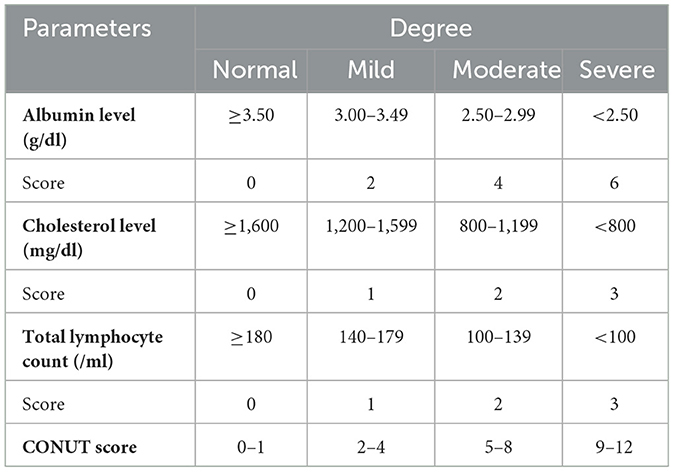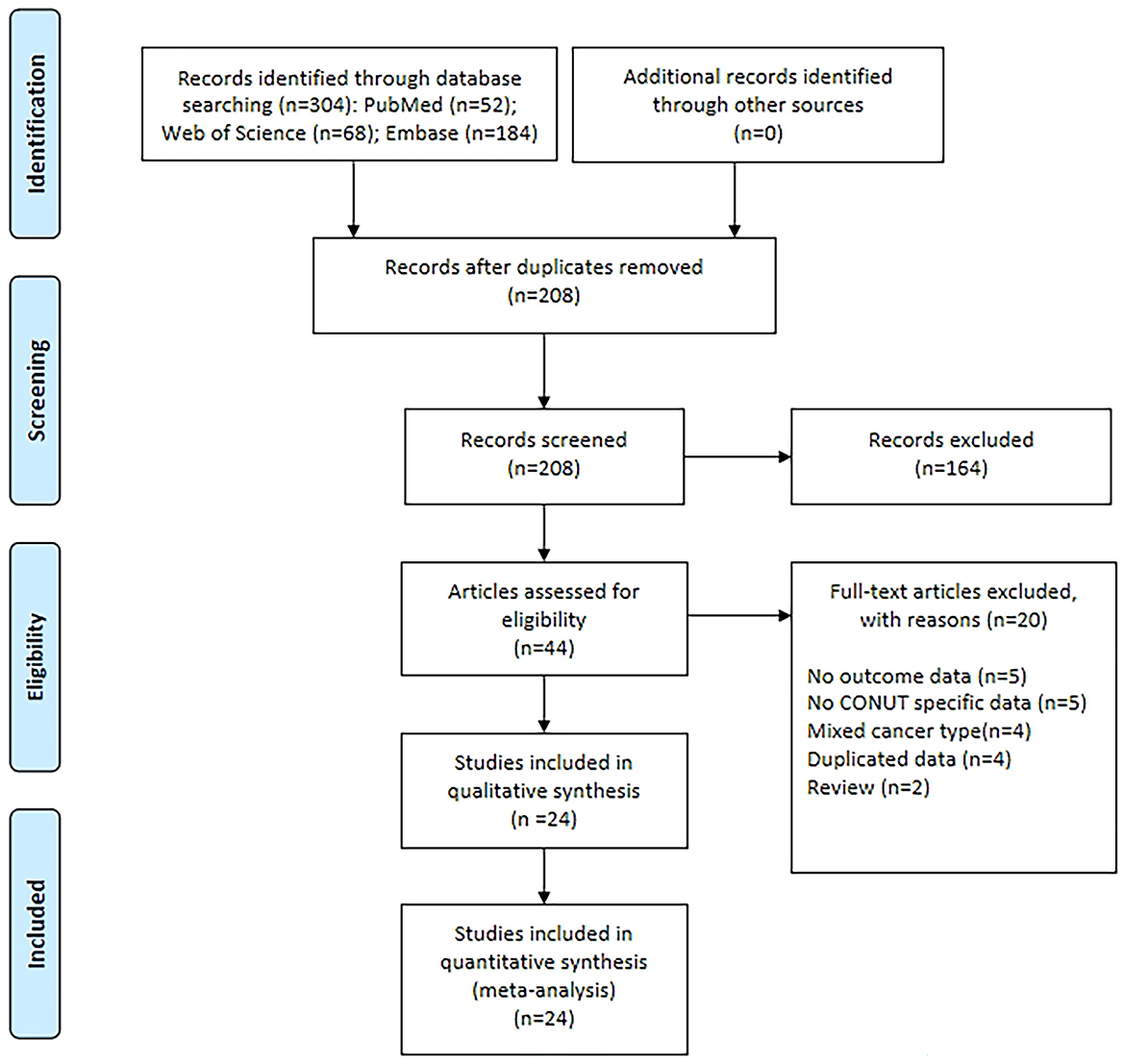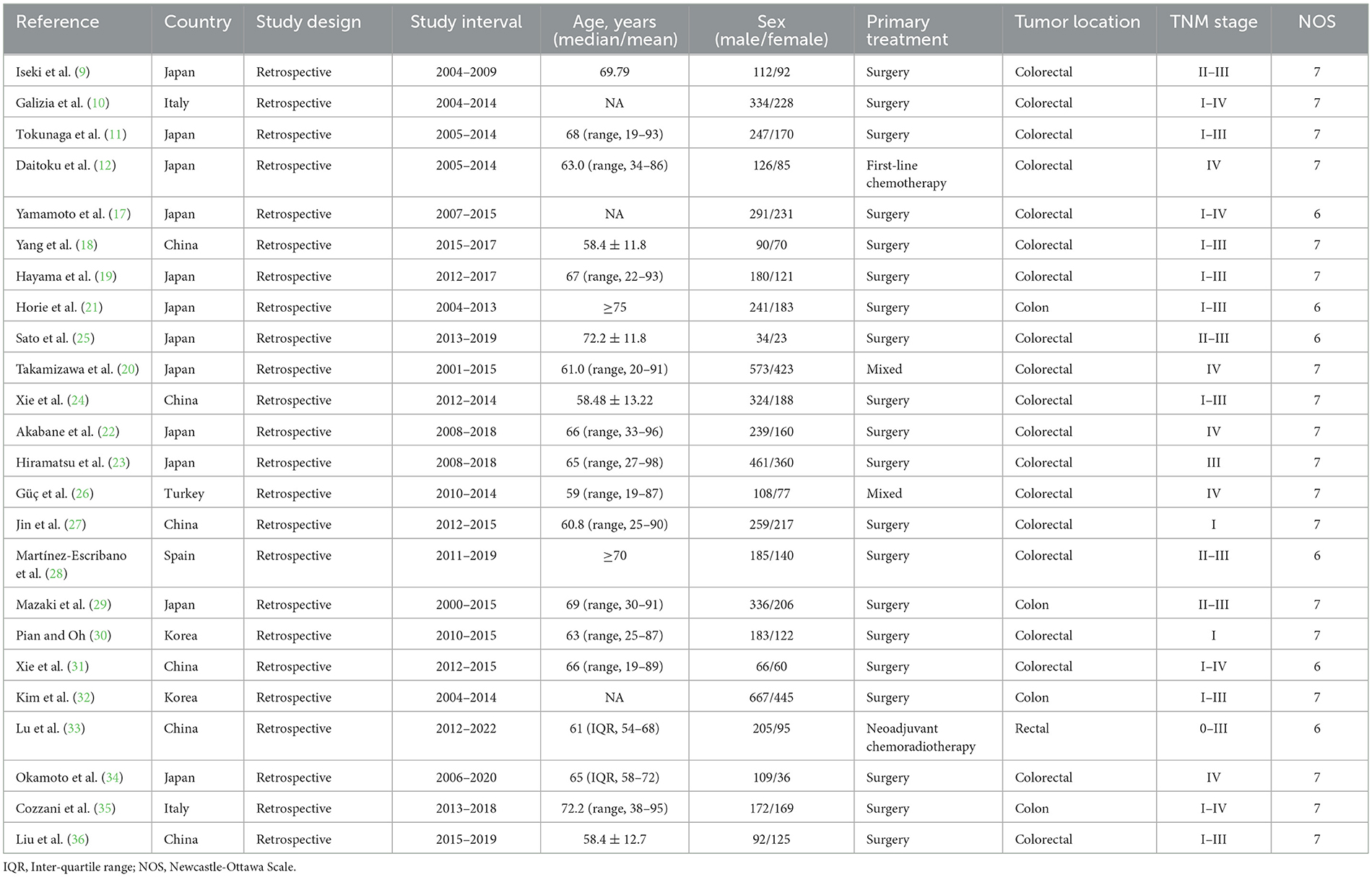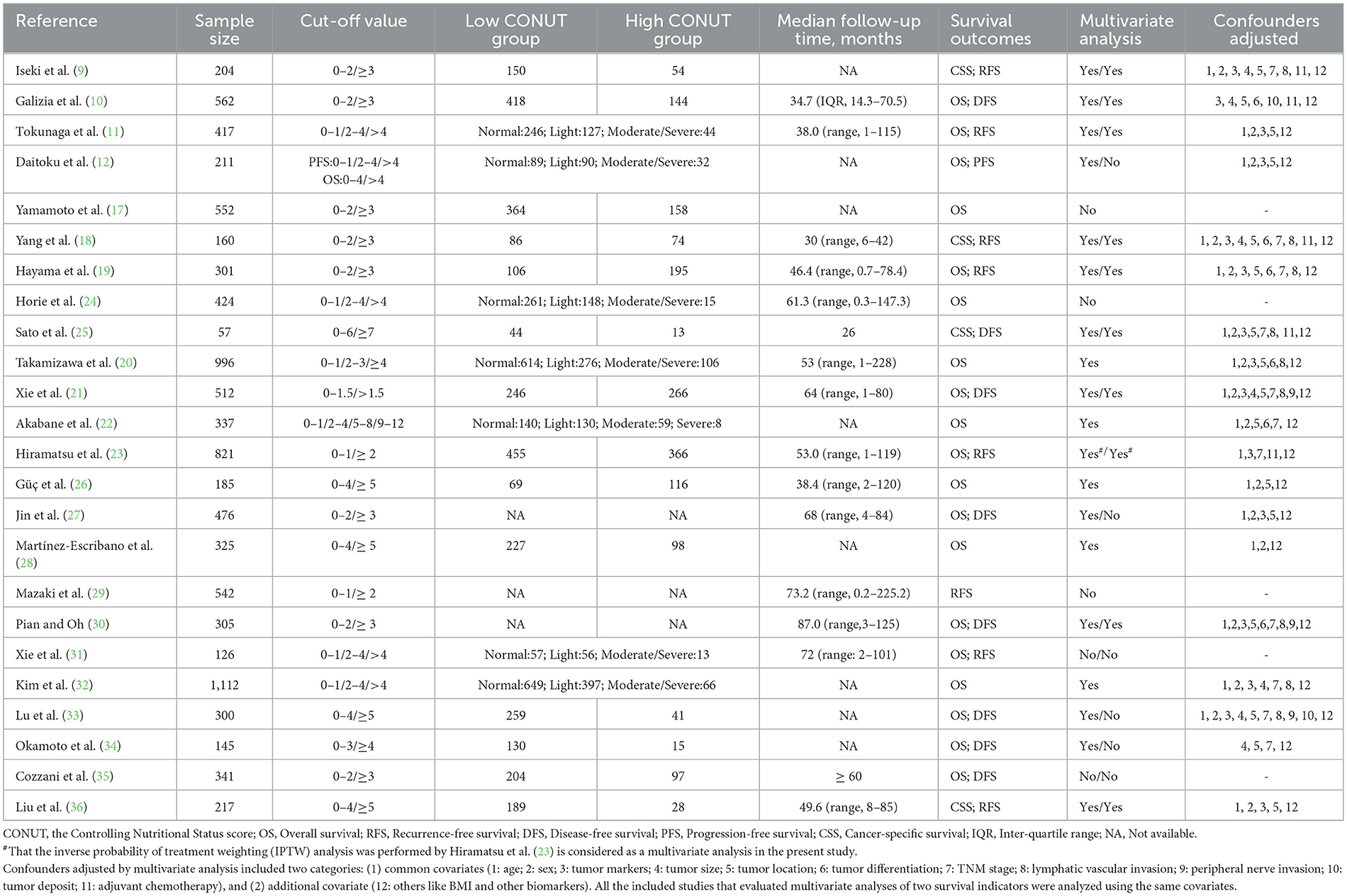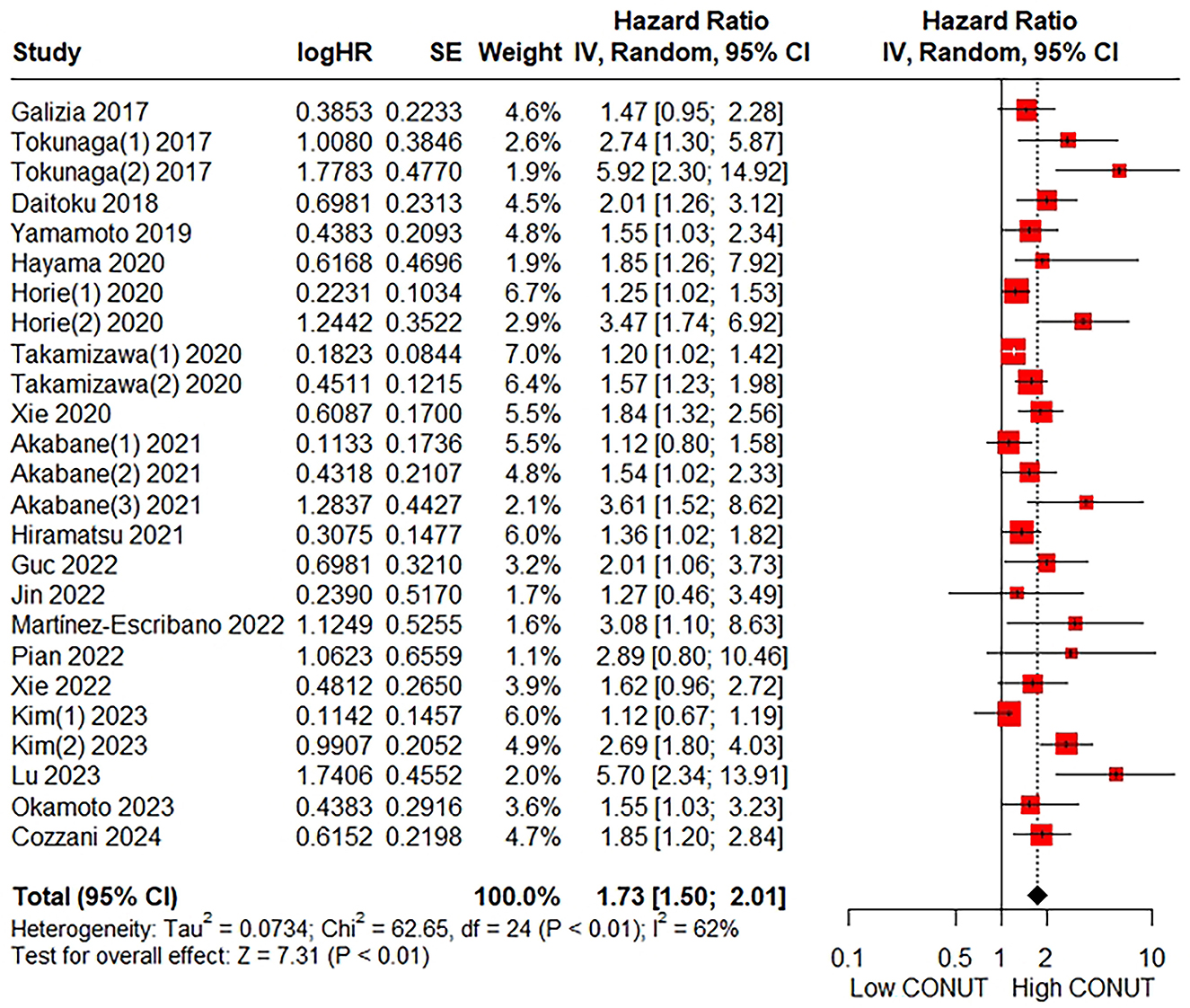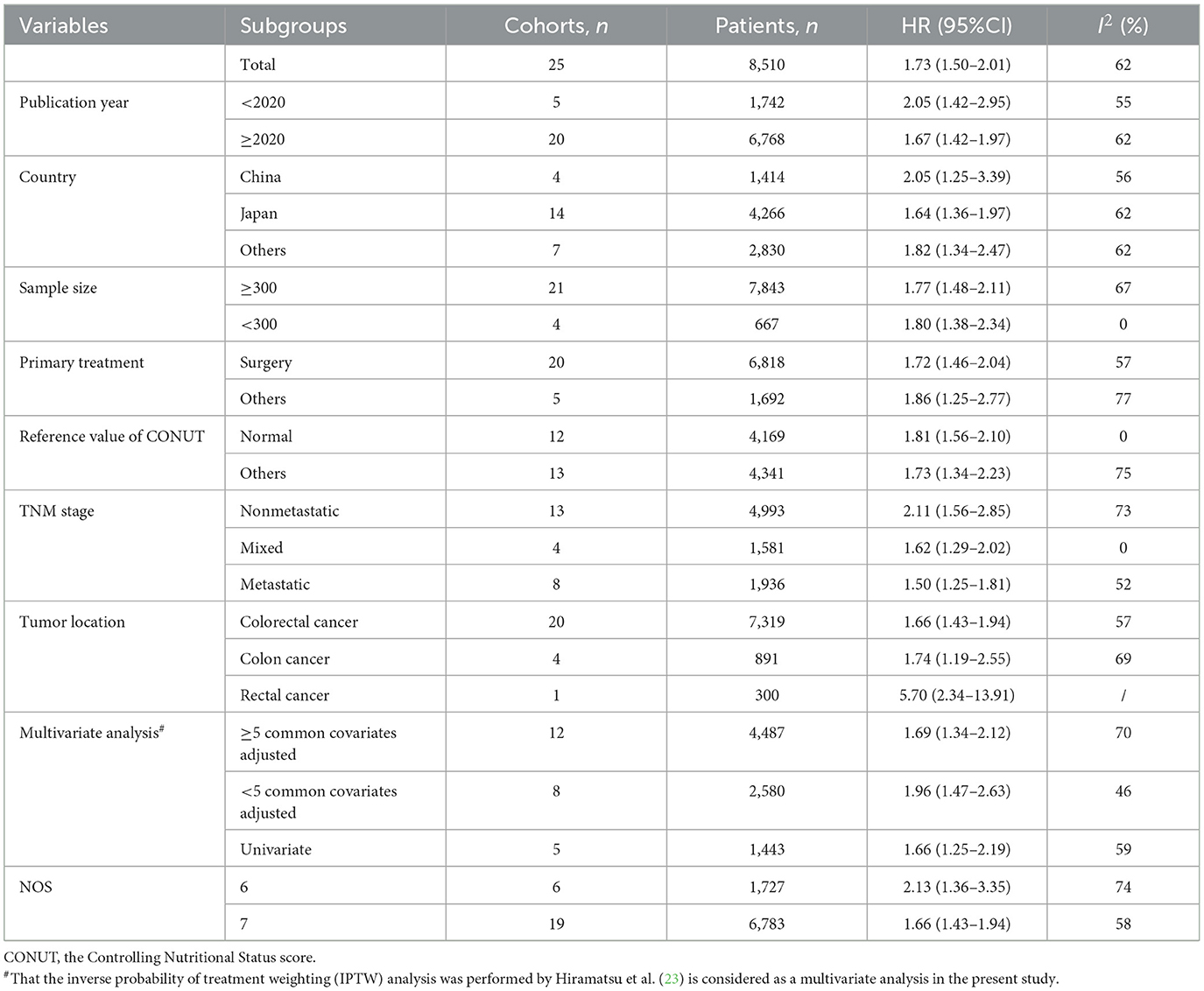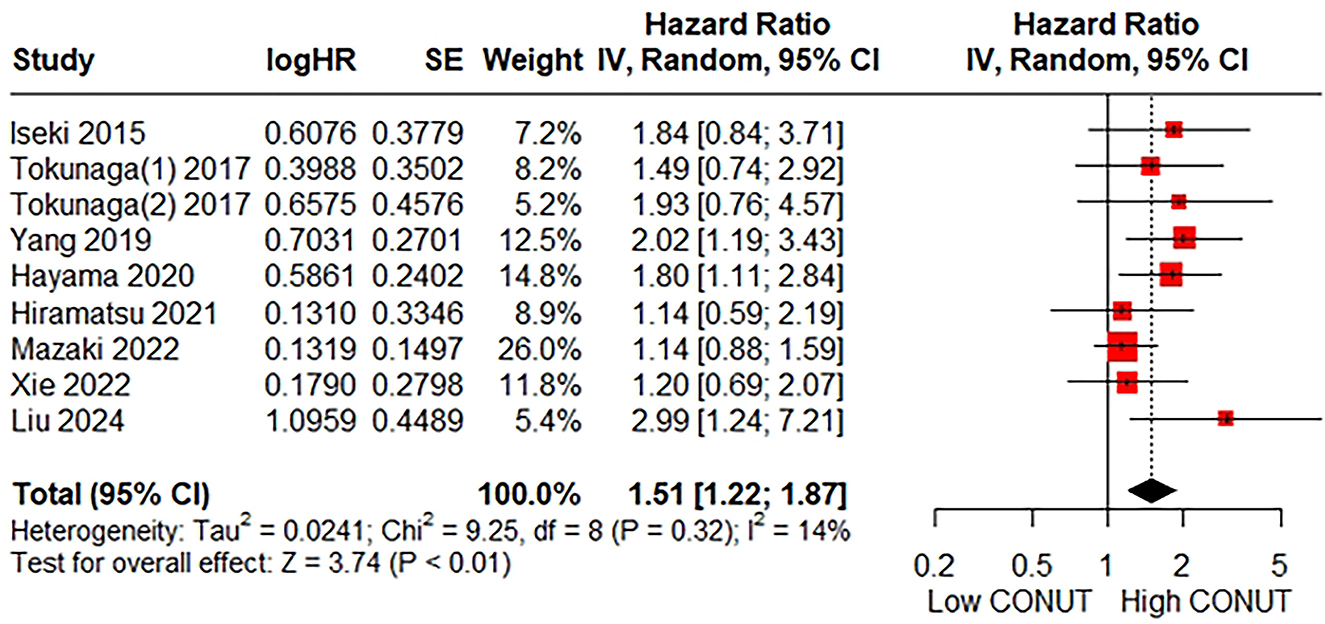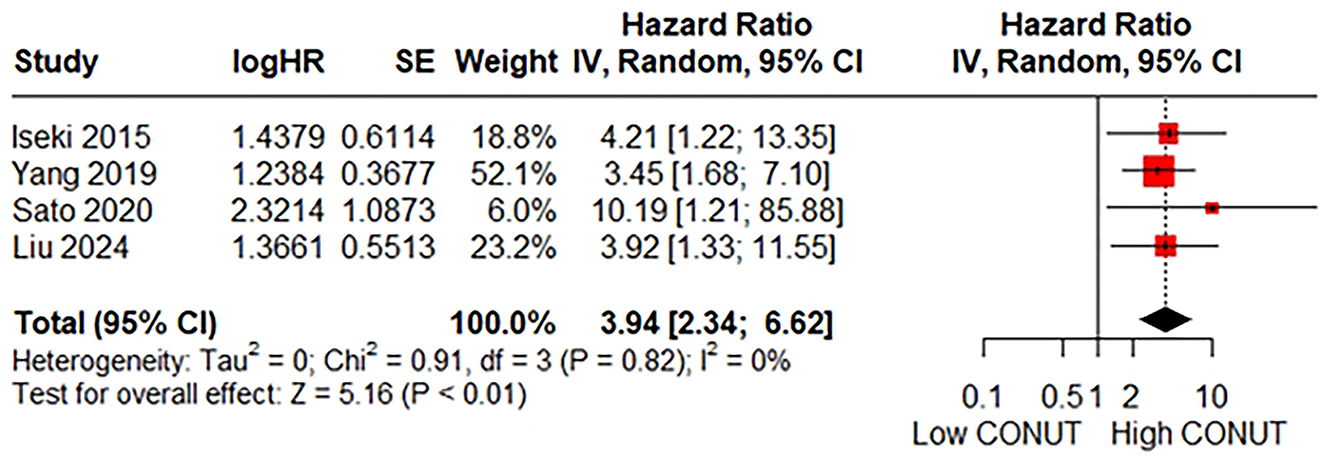- 1Department of Gastrointestinal Cancer Center, Chongqing University Cancer Hospital, Chongqing, China
- 2Department of Gastrointestinal Surgery, The First Affiliated Hospital of Chongqing Medical University, Chongqing, China
Background: The prognostic significance of the Controlling Nutritional Status (CONUT) score in colorectal cancer has been extensively reported, yet it remains unclear. This study aims to conduct an updated meta-analysis to evaluate the association between pretreatment CONUT score and long-term oncological outcomes in patients diagnosed with colorectal cancer.
Methods: A comprehensive literature search was conducted in PubMed, Embase, and Web of Science to identify eligible studies from inception to September 01, 2024, with an update on December 23, 2024. The primary endpoints evaluated were survival outcomes. Hazard ratios (HRs) with corresponding 95% confidence intervals (CIs) for survival outcomes were either extracted or calculated. A random-effects model was applied to pool all of the results. Statistical analyses were performed using R software, version 4.2.1.
Results: A total of 24 retrospective cohort studies including 9,628 colorectal cancer patients were included. The pooled results demonstrated that patients with higher CONUT score exhibited significantly poorer outcomes across multiple survival metrics: overall survival (HR = 1.73; 95%CI: 1.50–2.01; P < 0.01; I2 = 62%), recurrence-free survival (HR = 1.51; 95% CI: 1.22–1.87; P < 0.01; I2 = 14%), disease-free survival (HR = 1.61; 95% CI: 1.33–1.95; P < 0.01; I2 = 35%), and cancer-specific survival (HR = 3.94; 95% CI: 2.34–6.62; P < 0.01; I2 = 0%). Furthermore, an additional study indicated that the pre-treatment CONUT score may serve as a potential prognostic indicator for progression-free survival in colorectal cancer patients undergoing first-line chemotherapy (P < 0.05).
Conclusion: Our study demonstrates that the pretreatment CONUT score can serve as a valuable biomarker for predicting long-term oncological outcomes in patients with colorectal cancer.
1 Background
Colorectal cancer (CRC) remains the third most frequently diagnosed malignancy and the second leading cause of cancer-related mortality globally (1). Despite significant advancements in surgery, chemotherapy, radiotherapy, targeted therapy, and immunotherapy for CRC patients, clinical outcomes remain suboptimal (2). Currently, the tumor-node-metastasis (TNM) classification system is widely recognized as the predominant method for stratifying CRC prognoses. However, it is well-documented that significant variability exists in patient outcomes within the same TNM stage, particularly in stages II and III (3). This heterogeneity indicates that TNM staging alone may not comprehensively capture the full spectrum of prognostic outcomes. Consequently, there is an urgent need to develop biomarkers that can enhance the accuracy of patient stratification and identify individuals with adverse prognoses.
There is mounting evidence indicating that the nutritional status of cancer patients significantly influences both short-term treatment outcomes and long-term survival (4). Consequently, multiple nutritional indicators, including the NRS 2002 (5) and PG-SGA (6), have been utilized to predict the clinical outcomes of cancer patients. Nevertheless, those conventional nutritional assessment tools remain a subject of debate owing to their inherent complexity and susceptibility to subjective interpretation (4). Therefore, nutritional indicators derived from peripheral blood parameters have gradually emerged and continue to garner significant attention from researchers owing to their accessibility, non-invasiveness, and objectivity. Among them, the Controlled Nutritional Status (CONUT) score, which is calculated based on peripheral albumin levels, total cholesterol levels, and total lymphocyte counts, has emerged as a valuable nutritional screening tool (Table 1) (7). Recent literature extensively reports the clinical utility of the CONUT score in predicting both short- and long-term prognoses for solid tumors and hematologic malignancies (8). In 2015, Iski et al. (9) were the first to report the impact of the CONUT score on the prognosis of CRC patients undergoing radical surgery. Subsequently, numerous studies have further investigated the relationship between the CONUT score and clinical outcomes in CRC patients (10–12). In 2020, Takagi et al. (13) conducted a meta-analysis of six studies, preliminarily confirming the prognostic value of CONUT score in patients with CRC. However, they acknowledged that the number of included studies was limited, leaving the prognostic role of the CONUT score in CRC patients somewhat inconclusive. Given the growing body of recent research, we performed an updated meta-analysis to further elucidate the association between the pretreatment CONUT score and long-term oncological outcomes in CRC patients.
2 Methods
2.1 Search strategy
The present meta-analysis adhered to the Preferred Reporting Items for Systematic Reviews and Meta-Analyses (PRISMA) guidelines (14). A comprehensive search of relevant studies was conducted in PubMed, Embase, and Web of Science from inception to September 01, 2024, with an update on December 23, 2024. The search strategy employed a combination of keywords: (CONUT) AND (((colorectal) OR (colon) OR (rectum) OR (rectal)) AND ((cancer) OR (tumor) OR (carcinoma))). The detailed search strategy for each database was presented in Supplementary Table S1. No language restrictions were applied during the search. Furthermore, the reference lists of included studies were meticulously reviewed for additional relevant reports. Two investigators (SJK and WJL) independently performed the search.
2.2 Study selection
The inclusion criteria were as follows: (1) Studies that examined the association between the pretreatment CONUT score and survival outcomes in patients with CRC, including overall survival (OS), recurrence-free survival (RFS), disease-free survival (DFS), cancer-specific survival (CSS) and progression-free survival (PFS); (2) Hazard ratios (HRs) along with 95% confidence intervals (CIs) were either directly reported or could be calculated from the original literature; (3) The specific cut-off value for the CONUT score was clearly defined. The exclusion criteria were as follows: (1) Studies that did not provide separate data for CRC patients; (2) Case reports, reviews, conference papers, and letters; (3) Duplicate or overlapping datasets.
2.3 Data extraction and quality assessment
Two independent reviewers (SJK and WJL) conducted data extraction and cross-verified all results. The extracted data included critical information such as the first author, publication year, study period, country, study design, sample size, cut-off value of the CONUT score, and clinicopathological features including age, sex, primary treatment, tumor stage, tumor location, as well as survival outcomes and follow-up duration. The quality of the included studies was rigorously assessed using the Newcastle-Ottawa Scale (NOS) (15), which comprises eight predefined items. Each study was assigned a final score ranging from 0 to 9 based on a thorough evaluation; scores of 7–9 were deemed indicative of high-quality research.
2.4 Statistical analysis
The HRs along with their corresponding 95% CIs were used as the effect size for survival outcomes. When survival data were not directly reported in the literature, we extracted them from the survival curves using the methods outlined by Tierney et al. (16). Statistical heterogeneity among the included studies was evaluated using I2 statistics, and an I2 value of ≥ 50% was considered indicative of significant statistical heterogeneity. A random-effects model was utilized to synthesize HRs during the meta-analysis, given the substantial heterogeneity in clinical backgrounds across studies. Subgroup, sensitivity, and meta-regression analyses would be conducted to identify the potential sources of heterogeneity and evaluate the robustness of the pooled results in the presence of significant heterogeneity. A funnel plot along with Begg's and Egger's tests, was utilized to evaluate potential publication bias. For pooled outcomes exhibiting significant publication bias (Begg's test or Egger's test P < 0.1), the trim-and-fill method was further applied. A two-tailed P < 0.05 for pooled outcomes was considered statistically significant. All statistical analyses were performed using R software, version 4.2.1.
3 Results
3.1 Study characteristics
The database search yielded a total of 304 records, as shown in Figure 1. After a thorough evaluation of titles, abstracts, and full texts, 24 studies (9–12, 17–36) were ultimately included in this analysis. Tables 2, 3 provide comprehensive summaries of the basic characteristics and survival information of these included studies, respectively. Briefly, this meta-analysis encompassed a total of 9,628 patients from China, Japan, Korea, Turkey, Spain, and Italy. The publication years ranged from 2015 to 2024, with sample sizes varying between 57 and 1,112 individuals. Among the included studies, 19 focused on colorectal cancer, 4 on colon cancer, and 1 on rectal cancer. Regarding primary treatment modalities, 20 studies involved surgery, 2 studies involved mixed treatments, while neoadjuvant chemoradiotherapy and first-line chemotherapy were employed in 1 study each. Nineteen studies evaluated OS, 8 assessed RFS, 8 evaluated DFS, 4 evaluated CSS, and 1 assessed PFS. Notably, these studies demonstrated good quality, with NOS scores ranging from 6 to 7 (Table 3, Supplementary Table S2).
3.2 Relationship between the CONUT score and OS
The association between the CONUT score and OS was examined in 19 studies encompassing 8,510 patients. The pooled HR was 1.73 (95% CI: 1.50–2.01; P < 0.01), indicating a significant correlation between a higher CONUT score and poorer OS in CRC patients (Figure 2). Given the substantial heterogeneity observed (I2 = 62%), subgroup analyses were conducted to explore the stability of the pooled result across various factors, including publication year (< 2020 vs. ≥2020), country (China vs. Japan vs. Others), sample size (< 300 vs. ≥300), primary treatment modality (Surgery vs. Others), reference value for CONUT score (Normal vs. Others), TNM stage (Non-metastatic vs. Mixed vs. Metastatic), tumor location (Colorectal cancer vs. Colon cancer vs. Rectal cancer), multivariate analysis (≥5 common covariates adjusted vs. < 5 common covariates adjusted vs. Univariate), and NOS (6 vs. 7). As presented in Table 4 and Supplementary Figure S1, all subgroup analyses consistently demonstrated that patients with a higher CONUT score had significantly reduced OS compared to those with a lower CONUT score. Additionally, a multivariate meta-regression analysis based on the above parameters was performed. As shown in Supplementary Table S3, none of these factors were found to be the origin of potential sources of heterogeneity. Furthermore, sensitivity analysis by sequentially omitting each study showed no significant alteration in the overall outcome (Supplementary Figure S2).
3.3 Relationship between the CONUT score and RFS
A total of eight studies consisting of 2,788 patients reported on RFS. The pooled HR was HR = 1.51 (95%CI: 1.22–1.87; P < 0.01; I2 = 14%), indicating a significant association between a higher CONUT score and poorer RFS (Figure 3). Given the low heterogeneity of the pooled results, subgroup and sensitivity analyses were not performed.
3.4 Relationship between the CONUT and score DFS
The relationship between the CONUT score and DFS was assessed in eight studies involving 2,698 patients. The pooled HR was 1.61 (95% CI: 1.33–1.95; P < 0.01; I2 = 35%), suggesting a significant association between a higher CONUT score and poorer DFS (Figure 4). Similarly, due to the low heterogeneity of the pooled results, subgroup and sensitivity analyses were not conducted.
3.5 Relationship between the CONUT and score CSS
A total of four studies consisting of 638 patients reported on CSS. The pooled HR was HR = 3.94 (95% CI: 2.34–6.62; P < 0.01; I2 = 0%), indicating a significant association between a higher CONUT score and poorer CSS (Figure 5). Due to the absence of heterogeneity, subgroup and sensitivity analyses were not performed.
3.6 Relationship between the CONUT and score PFS
Regarding the relationship between the CONUT score and PFS, only one study investigated this association in metastatic colorectal cancer patients receiving first-line chemotherapy. This study demonstrated that a high CONUT score was significantly associated with poor PFS (P < 0.05).
3.7 Publication bias
The funnel plots, combined with Begg's and Egger's tests for the survival outcomes, are presented in Figure 6. These analyses revealed significant publication bias for OS (Begg's P = 0.0035, Egger's P < 0.0001), RFS (Begg's P = 0.3481, Egger's P = 0.0572), and CSS (Begg's P = 0.0894, Egger's P = 0.0367). However, no significant publication bias was observed for DFS (Begg's P = 0.2655, Egger's P = 0.2377). Trim-and-fill analyses further demonstrated that the pooled results remained robust after accounting for hypothetical unpublished studies: 11 additional studies for OS (HR = 1.39, 95% CI: 1.14–1.69, P < 0.01, I2 = 71.8%), 3 for RFS (HR = 1.34, 95% CI: 1.09–1.66, P < 0.01, I2 = 35.2%), and 2 for CSS (HR = 3.59, 95% CI: 2.25–5.72, P < 0.01, I2 = 0%). Due to the inclusion of only one study, the publication bias test for PFS was not conducted.
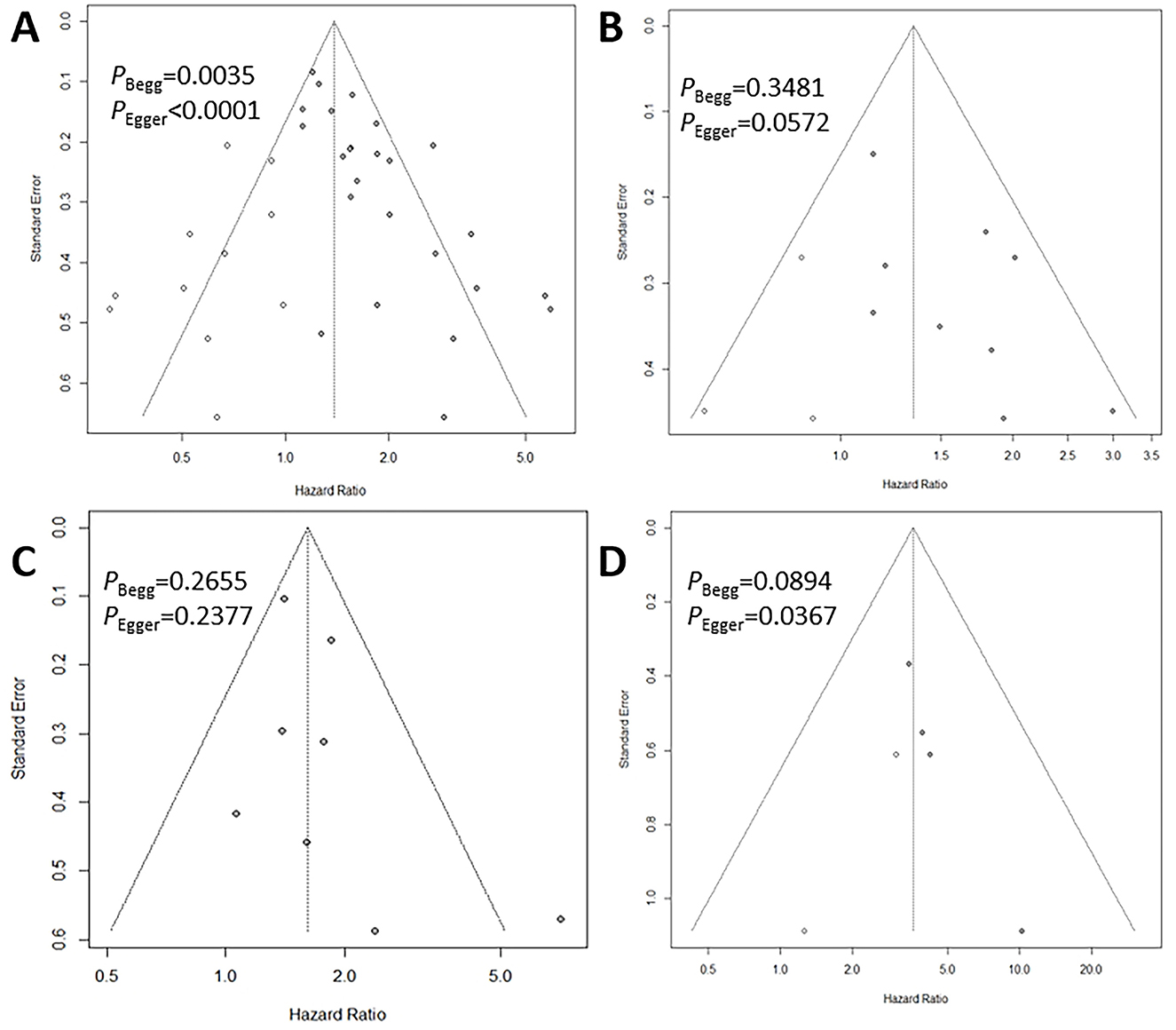
Figure 6. Begg's funnel plots assessing publication bias between the CONUT score and OS (A), RFS (B), DFS (C) and CSS (D).
4 Discussion
Malnutrition is highly prevalent among cancer patients, particularly in those with CRC, owing to factors such as malabsorption and bowel obstruction (37). Extensive evidence demonstrates that malnutrition can lead to prolonged hospital stays, increased postoperative complications, diminished sensitivity to postoperative treatments, and ultimately a poorer prognosis for cancer patients (38, 39). Therefore, the early identification and management of malnutrition are critical components of clinical practice for improving outcomes in CRC patients.
The CONUT score, as a nutritional assessment tool developed based on peripheral albumin levels, cholesterol levels, and total lymphocyte counts, possesses several advantages such as readily accessible data, straightforward calculation, non-invasive procedures, and objectivity (40). Consequently, an increasing number of studies have evaluated the prognostic value of CONUT score in various malignancies. In gastric cancer, a recent meta-analysis involving 9,764 patients demonstrated that patients in the high CONUT group exhibited poorer OS and RFS compared to those in the low CONUT group (4). Another meta-analysis by Liu et al. (41) confirmed that the CONUT score serves as a practical prognostic factor associated with the prognosis of biliary tract cancer. Additionally, the prognostic value of the CONUT score has been successfully validated in patients with head and neck cancer (42), breast cancer (43), hematological malignancies (44). In CRC, although a previous meta-analysis by Takagi et al. (13) in 2020 showed the significant efficacy of the CONUT score in predicting long-term survival, this study incorporated only 6 studies with 2,601 patients, resulting the conclusion unclear. Therefore, to further elucidate the prognostic value of CONUT score in CRC patients remains important.
By integrating data from 24 studies involving a total of 9,628 CRC patients, our meta-analysis revealed that patients in the high CONUT group had a 1.73-fold increased risk of poor OS. Given the substantial heterogeneity observed, subgroup analyses were conducted to investigate the robustness of the pooled results across various types of CRC patients. Consistently, the pretreatment CONUT score was identified as a significant prognostic biomarker across different regions, tumor locations, TNM stages, and primary treatments. However, despite sensitivity analysis supporting the stability of the findings, the sources of heterogeneity were not ascertained by meta-regression analysis. Additionally, it is important to acknowledge that the pooled result for OS showed significant publication bias. Nevertheless, after conducting trim-and-fill analysis, the pretreatment CONUT score remained a significant prognostic biomarker. Moreover, this meta-analysis demonstrated that patients in the high CONUT group faced a 1.51-, 1.61-, and 3.94-fold increased risk of poor RFS, DFS, and CSS, respectively. Notably, no significant heterogeneity was detected for these specific outcomes. Despite the presence of significant publication biases for RFS and CSS, the subsequent trim-and-fill analyses supported the reliability of these pooled results. Additionally, one included study initially examined the association between the CONUT score and PFS, yielding statistically significant results. Compared to the previous meta-analysis conducted 4 years ago (9), the present meta-analysis has several notable strengths. First, the larger sample size has narrowed the confidence intervals, enhancing the robustness of the findings. Second, our study encompassed a more diverse population with varying clinical characteristics, thereby increasing the generalizability of the prognostic value of the CONUT score. Finally, this study confirmed for the first time the predictive value of the CONUT score in DFS through meta-analysis.
The potential mechanism by which the CONUT score can effectively predict prognosis in CRC patients can be explained through the following aspects. First, serum albumin concentration serves as a critical indicator of liver function, nutritional status, and systemic inflammation (45). Pro-inflammatory cytokines such as IL-2 and IL-6 reduce albumin synthesis within hepatocytes, leading to decreased serum albumin levels (46). These cytokines also significantly promote cancer proliferation, invasion, and metastasis by accelerating cancer cell growth and compromising antitumor immunity via cytokine-mediated inflammatory responses (46). Furthermore, reduced serum albumin levels result in diminished synthesis of enzymes required for antibody production, weakened immune function, and compromised defense against tumors (47). Second, total cholesterol levels have been shown to strongly correlate with tumor growth and prognosis in various cancers (48). Although the precise role of cholesterol in cancer progression remains unclear, several studies have elucidated molecular mechanisms linking cancer progression and cholesterol metabolism (49, 50). Research suggests that an increased risk of cancer is inversely correlated with total serum cholesterol concentrations, possibly due to higher cholesterol content in tumor tissues compared to normal tissues, leading to reduced plasma cholesterol levels and caloric intake (49, 50). Additionally, mutations in genes involved in cholesterol metabolic pathways have been identified in cancer cells, potentially contributing to elevated intracellular cholesterol levels and promoting cancer cell growth (50). Finally, lymphocytes function as the primary effector cells of the immune system, orchestrating immune responses against tumor cells (51). Tumor-infiltrating lymphocytes produce a range of cytokines, including IFN-γ and TNF-α, which inhibit tumor growth and promote tumor cell apoptosis (52). CD8+ T cells can directly induce tumor cell death by releasing perforin and granzyme (53). Therefore, a decrease in lymphocyte count compromises the body's ability to effectively suppress tumor progression.
The current meta-analysis has several limitations. First, all included studies were retrospective in nature, which may introduce selection bias and highlights the need for further investigation through prospective studies. Second, the majority of the studies originated from Japan, indicating a potential regional bias and underscoring the necessity for more diverse international representation in future research. Finally, most patients underwent surgical treatment, limiting the generalizability of the CONUT score's predictive value in neoadjuvant therapy, first-line treatment, and subsequent lines of treatment, which require further exploration.
5 Conclusions
Our findings indicate that the pretreatment CONUT score may serve as a valuable prognostic biomarker for patients diagnosed with colorectal cancer, as individuals in the high CONUT group demonstrate significantly poorer long-term survival outcomes. Clinicians can leverage this informative indicator to stratify patients and tailor personalized treatment strategies. Nonetheless, additional research is warranted to validate the efficacy of this index in colorectal cancer prognosis.
Data availability statement
The original contributions presented in the study are included in the article/Supplementary material, further inquiries can be directed to the corresponding author.
Author contributions
JS: Conceptualization, Data curation, Formal analysis, Investigation, Methodology, Software, Visualization, Writing – original draft. JW: Data curation, Formal analysis, Funding acquisition, Methodology, Project administration, Resources, Software, Supervision, Validation, Visualization, Writing – review & editing.
Funding
The author(s) declare that financial support was received for the research and/or publication of this article. Project supported by the Natural Science Foundation of Chongqing, China (CSTB2023NSCQ-MSX-0370) and Project supported by the Clinical innovation team foundation of Chongqing Medical University, China (03030299QC-W0189).
Conflict of interest
The authors declare that the research was conducted in the absence of any commercial or financial relationships that could be construed as a potential conflict of interest.
Generative AI statement
The author(s) declare that no Gen AI was used in the creation of this manuscript.
Publisher's note
All claims expressed in this article are solely those of the authors and do not necessarily represent those of their affiliated organizations, or those of the publisher, the editors and the reviewers. Any product that may be evaluated in this article, or claim that may be made by its manufacturer, is not guaranteed or endorsed by the publisher.
Supplementary material
The Supplementary Material for this article can be found online at: https://www.frontiersin.org/articles/10.3389/fnut.2025.1560355/full#supplementary-material
References
1. Bray F, Laversanne M, Sung H, Ferlay J, Siegel RL, Soerjomataram I, et al. Global cancer statistics 2022: GLOBOCAN estimates of incidence and mortality worldwide for 36 cancers in 185 countries. CA Cancer J Clin. (2024) 74:229–63. doi: 10.3322/caac.21834
2. Liu H, Zhu D, Jiang D, Pang H, Yang X. Prognostic value of the pretreatment Naples prognostic score in patients with colorectal cancer: a systematic review and meta-analysis. Front Oncol. (2025) 14:1498854. doi: 10.3389/fonc.2024.1498854
3. Sugimoto A, Fukuoka T, Shibutani M, Kasashima H, Kitayama K, Ohira M, et al. Prognostic significance of the Naples prognostic score in colorectal cancer patients undergoing curative resection: a propensity score matching analysis. BMC Gastroenterol. (2023) 23:88. doi: 10.1186/s12876-023-02722-6
4. Liu H, Yang XC, Liu DC, Tong C, Wen W, Chen RH. Clinical significance of the controlling nutritional status (CONUT) score in gastric cancer patients: a meta-analysis of 9,764 participants. Front Nutr. (2023) 10:1156006. doi: 10.3389/fnut.2023.1156006
5. Liu J, Liu J, Chen H, Zhang Q, Zhang P, Chen Z, et al. Prognostic value of combined nutritional and inflammatory markers in NSCLC patients receiving ICIs. Discov Oncol. (2025) 16:571. doi: 10.1007/s12672-025-02391-9
6. Pinto Dos Santos M, Barbosa MV, Souza NC, Martucci RB. Malnutrition outweighs sarcopenia and adiposity as a predictor of survival in colorectal cancer patients. Nutr Res. (2025) 138:45–54. doi: 10.1016/j.nutres.2025.04.001
7. Ignacio de Ulíbarri J, González-Madroño A, de Villar NG, González P, González B, Mancha A, et al. CONUT: a tool for controlling nutritional status First validation in a hospital population. Nutr Hosp. (2005) 20:38–45.
8. Kheirouri S, Alizadeh M. Prognostic potential of the preoperative controlling nutritional status (CONUT) score in predicting survival of patients with cancer: a systematic review. Adv Nutr. (2021) 12:234–50. doi: 10.1093/advances/nmaa102
9. Iseki Y, Shibutani M, Maeda K, Nagahara H, Ohtani H, Sugano K, et al. Impact of the preoperative controlling nutritional status (CONUT) score on the survival after curative surgery for colorectal cancer. PLoS ONE. (2015) 10:e0132488. doi: 10.1371/journal.pone.0132488
10. Galizia G, Lieto E, Auricchio A, Cardella F, Mabilia A, Podzemny V, et al. Naples prognostic score, based on nutritional and inflammatory status, is an independent predictor of long-term outcome in patients undergoing surgery for colorectal cancer. Dis Colon Rectum. (2017) 60:1273–84. doi: 10.1097/DCR.0000000000000961
11. Tokunaga R, Sakamoto Y, Nakagawa S, Ohuchi M, Izumi D, Kosumi K, et al. CONUT: a novel independent predictive score for colorectal cancer patients undergoing potentially curative resection. Int J Colorectal Dis. (2017) 32:99–106. doi: 10.1007/s00384-016-2668-5
12. Daitoku N, Miyamoto Y, Tokunaga R, Sakamoto Y, Hiyoshi Y, Iwatsuki M, et al. Controlling nutritional status (CONUT) score is a prognostic marker in metastatic colorectal cancer patients receiving first-line chemotherapy. Anticancer Res. (2018) 38:4883–8. doi: 10.21873/anticanres.12802
13. Takagi K, Buettner S, Ijzermans JNM. Prognostic significance of the controlling nutritional status (CONUT) score in patients with colorectal cancer: a systematic review and meta-analysis. Int J Surg. (2020) 78:91–6. doi: 10.1016/j.ijsu.2020.04.046
14. Page MJ, McKenzie JE, Bossuyt PM, Boutron I, Hoffmann TC, Mulrow CD, et al. The PRISMA 2020 statement: an updated guideline for reporting systematic reviews. Int J Surg. (2021) 88:105906. doi: 10.1016/j.ijsu.2021.105906
15. Stang A. Critical evaluation of the Newcastle-Ottawa scale for the assessment of the quality of nonrandomized studies in meta-analyses. Eur J Epidemiol. (2010) 25:603–5. doi: 10.1007/s10654-010-9491-z
16. Tierney JF, Stewart LA, Ghersi D, Burdett S, Sydes MR. Practical methods for incorporating summary time-to-event data into meta-analysis. Trials. (2007) 8:16. doi: 10.1186/1745-6215-8-16
17. Yamamoto M, Saito H, Uejima C, Tanio A, Tada Y, Matsunaga T, et al. Prognostic value of combined tumor marker and controlling nutritional status (CONUT) score in colorectal cancer patients. Yonago Acta Med. (2019) 62:124–30. doi: 10.33160/yam.2019.03.017
18. Yang C, Wei C, Wang S, Han S, Shi D, Zhang C, et al. Combined features based on preoperative controlling nutritional status score and circulating tumour cell status predict prognosis for colorectal cancer patients treated with curative resection. Int J Biol Sci. (2019) 15:1325–35. doi: 10.7150/ijbs.33671
19. Hayama T, Ozawa T, Okada Y, Tsukamoto M, Fukushima Y, Shimada R, et al. The pretreatment controlling nutritional status (CONUT) score is an independent prognostic factor in patients undergoing resection for colorectal cancer. Sci Rep. (2020) 10:13239. doi: 10.1038/s41598-020-70252-2
20. Takamizawa Y, Shida D, Boku N, Nakamura Y, Ahiko Y, Yoshida T, et al. Nutritional and inflammatory measures predict survival of patients with stage IV colorectal cancer. BMC Cancer. (2020) 20:1092. doi: 10.1186/s12885-020-07560-3
21. Xie H, Nong C, Yuan G, Huang S, Kuang J, Yan L, et al. The value of preoperative controlling nutritional status score in evaluating short-term and long-term outcomes of patients with colorectal cancer following surgical resection. J Cancer. (2020) 11:7045–56. doi: 10.7150/jca.49383
22. Akabane M, Shindoh J, Kobayashi Y, Umino R, Kojima K, Okubo S, et al. Significance of preoperative nutritional status as a predictor for short-term and long-term outcomes of patients undergoing surgery for stage IV colorectal cancer. Langenbecks Arch Surg. (2021) 406:2391–8. doi: 10.1007/s00423-021-02255-0
23. Hiramatsu K, Shindoh J, Hanaoka Y, Toda S, Ueno M, Matoba S, et al. Postoperative nutritional status is predictive of the survival outcomes in patients undergoing resection of stage III colorectal cancer. World J Surg. (2021) 45:3198–205. doi: 10.1007/s00268-021-06202-4
24. Horie T, Shida D, Ahiko Y, Takamizawa Y, Inoue M, Tanabe T, et al. Laparoscopic versus open colectomy for elderly patients with colon cancer: a propensity score analysis with the controlling nutritional status (CONUT) score. Nutr Cancer. (2021) 73:246–51. doi: 10.1080/01635581.2020.1743868
25. Sato R, Oikawa M, Kakita T, Okada T, Abe T, Yazawa T, et al. The controlling nutritional status (CONUT) score as a prognostic factor for obstructive colorectal cancer patients received stenting as a bridge to curative surgery. Surg Today. (2021) 51:144–52. doi: 10.1007/s00595-020-02066-8
26. Güç ZG, Altay C, Özgül HA, Ellidokuz H, Yavuzşen T. GNRI and conut scores: simple predictors of sarcopenia in metastatic colorectal cancer patients. Support Care Cancer. (2022) 30:7845–52. doi: 10.1007/s00520-022-07218-9
27. Jin Z, Wu Q, Deng X, Wang Z. The clinic factors in evaluating long-term outcomes of patients with stage I colorectal cancer. Asian J Surg. (2022) 45:2231–8. doi: 10.1016/j.asjsur.2021.11.055
28. Martínez-Escribano C, Arteaga Moreno F, Pérez-López M, Cunha-Pérez C, Belenguer-Varea Á, Cuesta Peredo D, et al. Malnutrition and increased risk of adverse outcomes in elderly patients undergoing elective colorectal cancer surgery: a case-control study nested in a cohort. Nutrients. (2022) 14:207. doi: 10.3390/nu14010207
29. Mazaki J, Katsumata K, Tago T, Kasahara K, Enomoto M, Ishizaki T, et al. Novel and simple nomograms using inflammation and nutritional biomarkers for stage II-III colon cancer, taking “time after curative surgery” into consideration. Nutr Cancer. (2022) 74:2875–86. doi: 10.1080/01635581.2022.2042570
30. Pian G, Oh SY. Comparison of nutritional and immunological scoring systems predicting prognosis in T1-2N0 colorectal cancer. Int J Colorectal Dis. (2022) 37:179–88. doi: 10.1007/s00384-021-04043-0
31. Xie Z, Zhou H, Wang L, Wu Y. The Significance of the preoperative lactate dehydrogenase/albumin ratio in the prognosis of colon cancer: a retrospective study. PeerJ. (2022) 10:e13091. doi: 10.7717/peerj.13091
32. Kim H, Shin DM, Lee JH, Cho ES, Lee HS, Shin SJ, et al. Combining prognostic nutritional index (PNI) and controlling nutritional status (CONUT) score as a valuable prognostic factor for overall survival in patients with stage I-III colorectal cancer. Front Oncol. (2023) 13:1026824. doi: 10.3389/fonc.2023.1026824
33. Lu S, Chen Z, Peng R, Zhang Q, Wang Y, Li X, et al. Prognostic effect of preoperative controlling nutritional status score in patients with locally advanced rectal cancer: a two-center, retrospective study. Nutrition. (2023) 112:112078. doi: 10.1016/j.nut.2023.112078
34. Okamoto A, Furukawa K, Ohkuma M, Nakano T, Yoshioka S, Imaizumi Y, et al. Clinical significance of controlling nutritional status (CONUT) score in patients with colorectal liver metastases after hepatectomy. In Vivo. (2023) 37:2678–86. doi: 10.21873/invivo.13377
35. Cozzani F, Ricchiuto M, Virgilio E, Viani L, Rossini M, Pedrazzi G, et al. The controlling nutritional status (CONUT) score predicts post-operatory risks and prognosis in patients with surgically treated colon cancer: a retrospective study. Anticancer Res. (2024) 44:3955–64. doi: 10.21873/anticanres.17224
36. Liu LX, Wang H, Gao B, Xu TT, Yuan QG, Zhou SZ, et al. Preoperative controlling nutritional status as an optimal prognostic nutritional index to predict the outcome for colorectal cancer. World J Gastrointest Oncol. (2024) 16:343–53. doi: 10.4251/wjgo.v16.i2.343
37. Benoist S, Brouquet A. Nutritional assessment and screening for malnutrition. J Visc Surg. (2015) 152:S3–7. doi: 10.1016/S1878-7886(15)30003-5
38. Pang H, Dai L, Chen L, Chen X, Chen Z, Zhang S, et al. Prognostic value of the advanced lung cancer inflammation index in patients with gastric cancer after radical gastrectomy: a propensity-score matching cohort study and meta-analysis. BMC Cancer. (2024) 24:583. doi: 10.1186/s12885-024-12349-9
39. Zhao Z, Yan M, Pang H, Chen L, Tang X, Chen Z, et al. Significance of nutritional-inflammatory index as predictors for total neoadjuvant therapy-induced tumor regression in locally advanced rectal cancer patients. J Inflamm Res. (2024) 17:3865–78. doi: 10.2147/JIR.S462985
40. González-Madroño A, Mancha A, Rodríguez FJ, Culebras J, de Ulibarri JI. Confirming the validity of the CONUT system for early detection and monitoring of clinical undernutrition: comparison with two logistic regression models developed using SGA as the gold standard. Nutr Hosp. (2012) 27:564–71. doi: 10.1590/S0212-16112012000200033
41. Liu Z, Zhou H, Zhou Y, Yu M, Cheng Y, Li J. Prognostic impact of the controlling nutritional status score in patients with biliary tract cancer: a systematic review and meta-analysis. Front Oncol. (2023) 13:1240008. doi: 10.3389/fonc.2023.1240008
42. Wang Y, Qian C. Prognostic and clinicopathological value of the controlling nutritional status (CONUT) score in patients with head and neck cancer: a meta-analysis. World J Surg Oncol. (2024) 22:223. doi: 10.1186/s12957-024-03505-3
43. Prasetiyo PD, Baskoro BA, Hariyanto TI. The role of nutrition-based index in predicting survival of breast cancer patients: a systematic review and meta-analysis. Heliyon. (2024) 10:e23541. doi: 10.1016/j.heliyon.2023.e23541
44. Lu G, Li Q. The controlling nutritional status score as a predictor of survival in hematological malignancies: a systematic review and meta-analysis. Front Nutr. (2024) 11:1402328. doi: 10.3389/fnut.2024.1402328
45. Oymak E, Guler OC, Onal C. Prognostic significance of albumin and globulin levels in cervical cancer patients treated with chemoradiotherapy. Int J Gynecol Cancer. (2023) 33:19–25. doi: 10.1136/ijgc-2022-003768
46. Chang PH, Pan YP, Fan CW, Tseng WK, Huang JS, Wu TH, et al. Pretreatment serum interleukin-1β, interleukin-6, and tumor necrosis factor-α levels predict the progression of colorectal cancer. Cancer Med. (2016) 5:426–33. doi: 10.1002/cam4.602
47. Liu Z, Diao Y, Li X. Body mass index and serum markers associated with progression-free survival in lung cancer patients treated with immune checkpoint inhibitors. BMC Cancer. (2022) 22:824. doi: 10.1186/s12885-022-09744-5
48. Zhou P, Li B, Liu B, Chen T, Xiao J. Prognostic role of serum total cholesterol and high-density lipoprotein cholesterol in cancer survivors: a systematic review and meta-analysis. Clin Chim Acta. (2018) 477:94–104. doi: 10.1016/j.cca.2017.11.039
49. Tsai YT, Tsai MH, Kudva A, Vito A, Lai CH, Liao CT, et al. The prognostic value of preoperative total cholesterol in surgically treated oral cavity cancer. Biomedicines. (2024) 12:2898. doi: 10.3390/biomedicines12122898
50. Wang HX, Ding C, Huang JC, Ma YW, Lyu SC, Lang R, et al. Prognostic value for perioperative serum total cholesterol level on postoperative long-term prognosis of pancreatic cancer: a retrospective clinical study. Diagnostics. (2023) 13:1402. doi: 10.3390/diagnostics13081402
51. Yang M, Lin SQ, Liu XY, Tang M, Hu CL, Wang ZW, et al. Association between C-reactive protein-albumin-lymphocyte (CALLY) index and overall survival in patients with colorectal cancer: from the investigation on nutrition status and clinical outcome of common cancers study. Front Immunol. (2023) 14:1131496. doi: 10.3389/fimmu.2023.1131496
52. Hou Y, Li X, Yang Y, Shi H, Wang S, Gao M. Serum cytokines and neutrophil-to-lymphocyte ratio as predictive biomarkers of benefit from PD-1 inhibitors in gastric cancer. Front Immunol. (2023) 14:1274431. doi: 10.3389/fimmu.2023.1274431
Keywords: colorectal cancer, controlling nutritional status score, overall survival, recurrence-free survival, disease-free survival, cancer-specific survival, progression-free survival, meta-analysis
Citation: Shang J and Wei J (2025) Prognostic significance of the pretreatment controlling nutritional status score in colorectal cancer patients: an updated meta-analysis with 24 cohort studies. Front. Nutr. 12:1560355. doi: 10.3389/fnut.2025.1560355
Received: 14 January 2025; Accepted: 09 May 2025;
Published: 30 May 2025.
Edited by:
William Kwame Amakye, South China University of Technology, ChinaReviewed by:
Yosi Yohanes Putra Tandi, RSUPN Dr. Cipto Mangunkusumo, IndonesiaAndrea Costanzi, ASST Lecco, Italy
Copyright © 2025 Shang and Wei. This is an open-access article distributed under the terms of the Creative Commons Attribution License (CC BY). The use, distribution or reproduction in other forums is permitted, provided the original author(s) and the copyright owner(s) are credited and that the original publication in this journal is cited, in accordance with accepted academic practice. No use, distribution or reproduction is permitted which does not comply with these terms.
*Correspondence: Jinlai Wei, d2VpbGFpMDMxMDlAMTYzLmNvbQ==
 Jingkun Shang1
Jingkun Shang1 Jinlai Wei
Jinlai Wei